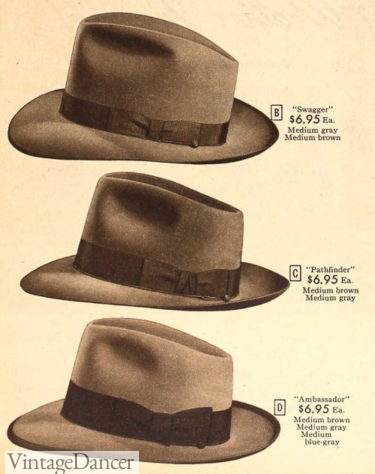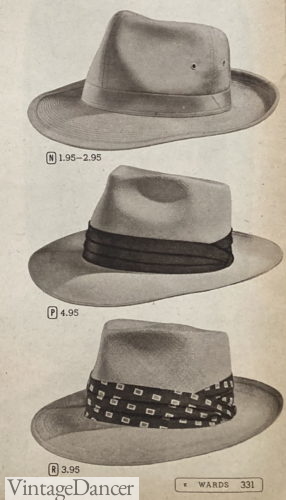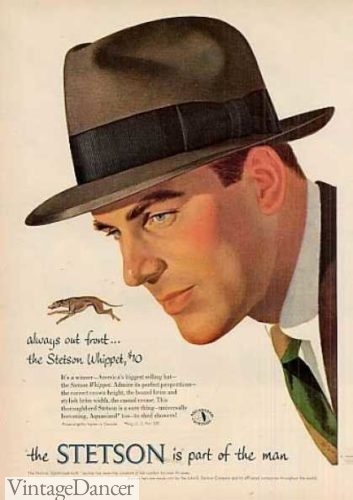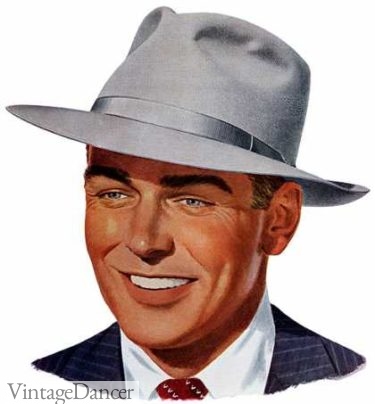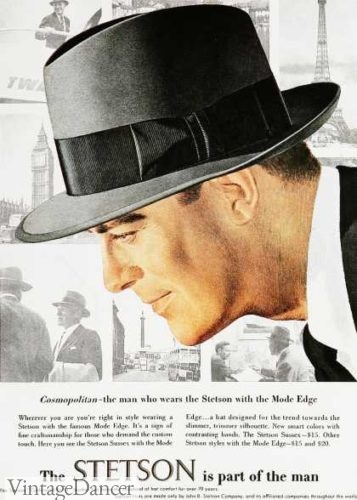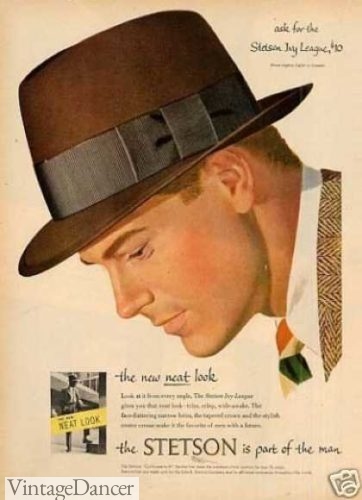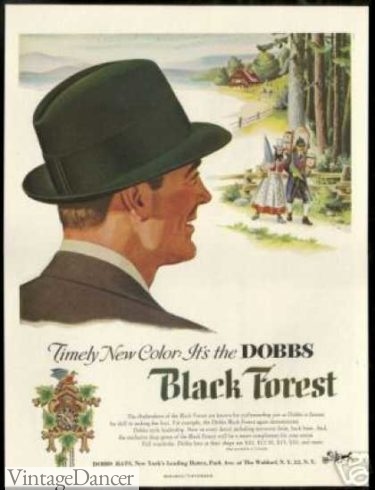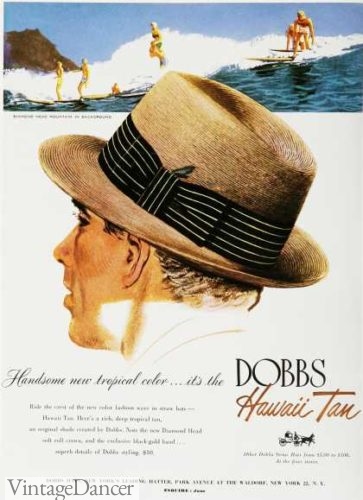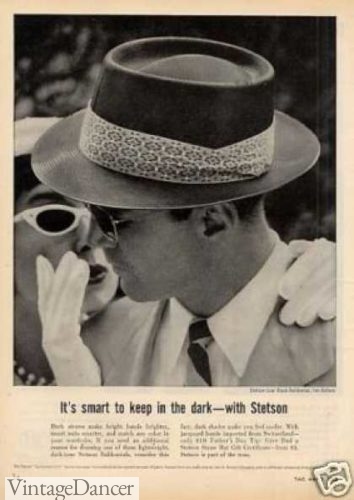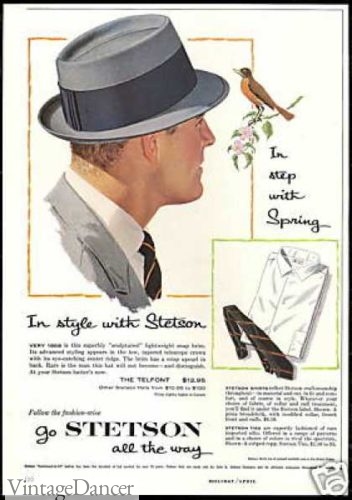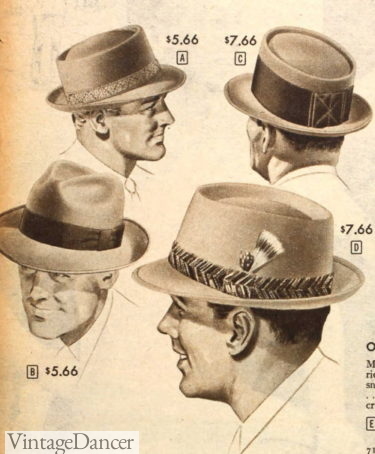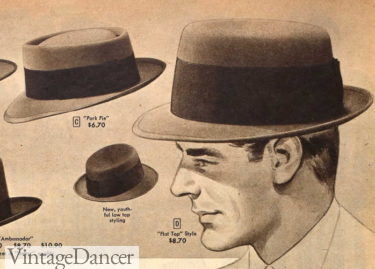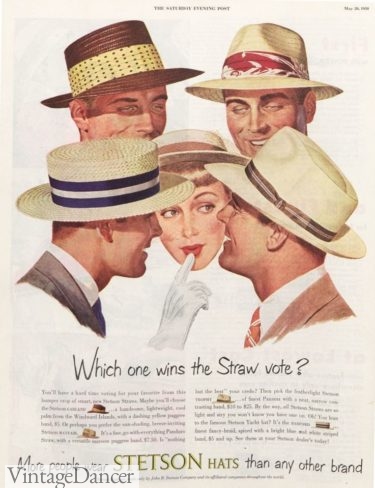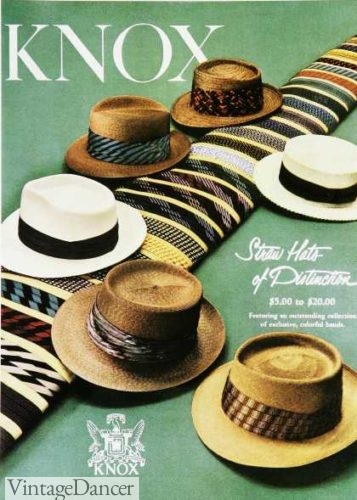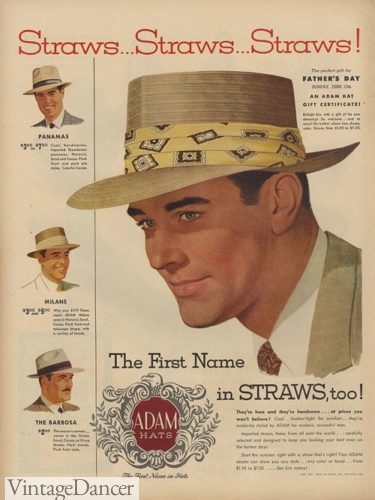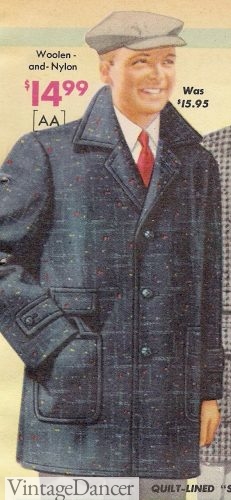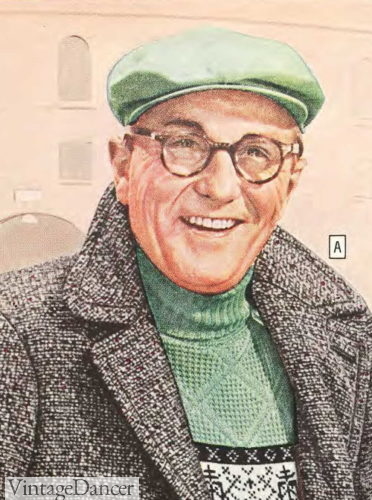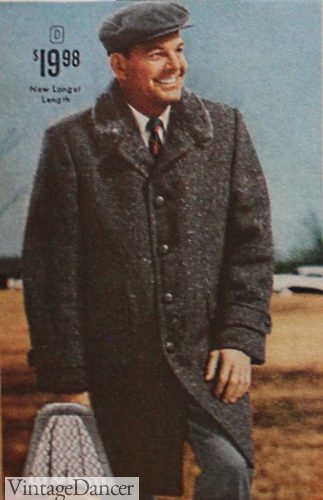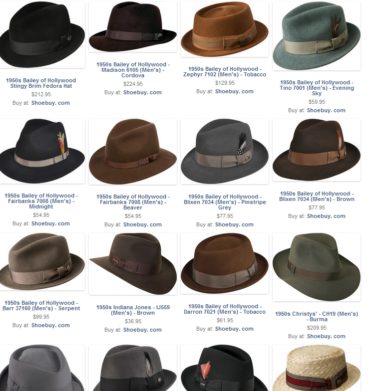The 1950s were a great time for men’s hats. After two decades of little change in style or variety, the 1950s came rolling in with splashes of color and fun new shapes. Little did they know that this would become the last decade of men wearing hats as required fashion. It was both the golden age and the end of an age for men in hats.
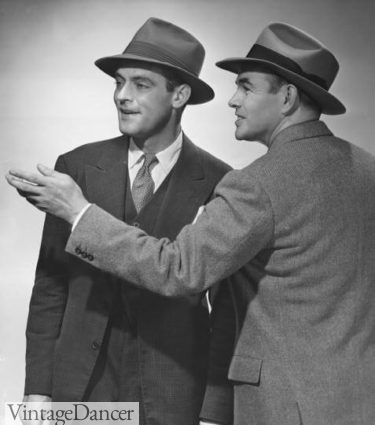
Let us take a look at the styles of 1950s men’s hats and see just why they were so special.
Hats of the 1950s – Fedora or Trilby Hat
The new “Bold look” of the early 1950s, had men in lean suits with elongated lapels, straight lines, and bland colors. His hat needed to compliment the lean look with a tall crown that tapered in on the sides and had a strong snap down brim. Wide grosgrain hat bands and contrast binding (ie grey binding on a brown hat) made the look stand apart from 1940s fedoras.
The Fedora hat style never went out of fashion but Old Blue Eyes, Frank Sinatra, certainly helped keep it in style throughout the 1950s. He wore all types of fedoras, but it was his late 1950s stingy brim fedora that really made a lasting impression on hat history. Today the stingy brim fedora is incredibly popular with fashionable young men, just as it was in the ’50s and ’60s.
- 1952
- 1954
- 1953
- Mid 50s
Fedora hats in the second half of the decade shrunk. Crowns were shorter, with noticeably tapered sides, and a tilted back, downward slope. Brims widths shrunk from almost 3 inches down to 2 1/4 or 2 1/8 inches.
- Colors: Brown, Tan, Green, Blue, Grey, Black
- Material: Fur felt or woven straw
- Shape: Center crown crease, usually pinch front
- Brim: Narrow brim, increasingly narrower as the 50s progressed. Brim turned down in front and up at sides with a deep turn up at the back. A narrow fedora brim is often called a Stingy brim.
- Band: Solid Petersham or silk ribbon colors that contrasted with the hat such as a green band on a grey hat. Flat bow on the side often with feather accent. Late 50’s brought in thin leather bands or felt bands to match the hat body and knotted instead of a bow. Hat brim was either unlined to lined in matching Petersham ribbon.
- Style: Centered on head with a slight tilt forward in the early 50s. Centered on head with a tilt back in the later 50s.
Tremont
A cross between homburg and fedora was the newest men’s’ dressy hat, the Tremont. The crown had a center dent on top, straight sides and a narrow snap brim. The downward front brim gave the hat a more casual look while an upturned brim was dressier. With a pinched crown and snapped brim the Tremont was at its most informal. Not that formality of casualness matter to the average man.
1950s Pork Pie Hats
The popular 1940s men’s hat returns in the 1950s with more colors and simpler, more refined style. It was usually called a telescope crown hat with a flat top or the classic pork pie but with a taller crown and wide hat band. Common colors were dark brown or dark grey. Brim widths narrow at the end of the decade to around 2 inches.
The flat top hat called a terrace top was seen in the late 1950s, as an alternative to the pork pie with creased inner ring. The hat band was very wide, covered three quarters of the crown.
- 1955 pork pie hat with medallion hat band
- Stetson pork pie with wide bow hat band
- 1958 pork pie hats
- 1956 porkpie and flat top telescope hat
- Colors: Light browns, olive-green.
- Material: Fur felt or straw.
- Shape: Short, oval flat top with deep crease around oval.
- Brim: Flat brim all around or slightly curled just at the back.
- Band: Wide grosgrain or silk ribbon with flat bow or twist tie.
- Style: Worn at an angle or tilted back.
1950s Straw Hats
Straw hats came in different shapes and natural colors just like their felt cousins did. Boaters, fedoras, Panamas, telescope and pork pie hats all came in woven straw. Brim sizes were everything from 3 inches down to 2 inches. Typically brims were wider with straw hats than with felt hats.
The unique qualities of 1950s straw hats were in the bold and colorful hat bands. Wide silks, pleated puggaree, and grosgrain ribbons in bold stripes, checks, and geometric print patterns matched the colorful suits 1950s men were wearing. The newest fabrics were cotton Madras and Indian prints with gold thread. Cheap rayon and cotton blends were also used.
Coconut straw with a bandana print hat band and matching pocket square became trendy at vacation destinations. Tropical Hawaiian prints, palm trees, bananas, and polka dots rounded out some of the novelty designs. Straw hats were cheap and plentiful, a man could own several for each season.
Panama, Milan, Sennit, Raffia, Umbria Pala, Bari bread, and reed were just some of the straws used in 1950s hats.
- Colors: Natural yellow straw, beached white straw and shades of coconut browns.
- Material: Thick, thin, natural and synthetic hand-woven straws.
- Shape: Same as felt varieties. Usually more brim in the front and less in the back for sun shading.
- Brim: Many curved to the back, some to the front.
- Band: Wide silk ribbon in early ’50s, thinner silk ties in later ’50s.
- Style: Worn same as felt varieties.
- Pictured below: Straw Boater, Straw Fedora, Straw Trilby, Straw Pork pie.
1950s-1960s Men’s Walking Hat
The hat that was more common in Europe than in the USA was the tweed walking cap. Many colorful patterns of Harris tweed made this a cool weather hat. It increased in popularity through to the 1960s.
-
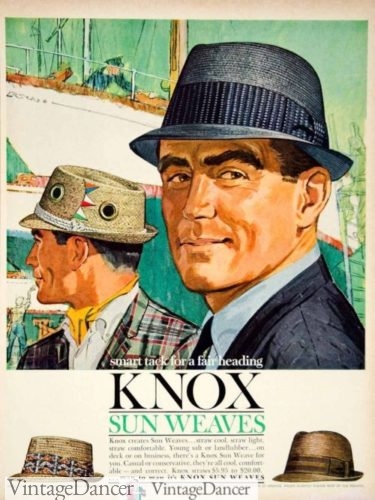
1960 Knox straw walking hat
- Material: Wool tweed, summer cotton plaids.
- Shape: Tall round crown shaped the head snugly.
- Brim: Narrow brim angled down all around and turned up at the back.
- Band: Thin self fabric band with tie, bow, or clip onside.
- Style: Worn snug over head and forehead.
The end of the decade saw a great variety of hat shapes, textures, fabrics, narrow brims, and colors. Everything and anything was thrown onto a hat, trying to get more men to buy into the fun and colorful fashions that defined the 1960s.
Many of these new hats had already been worn by the Urban male, specifically Black Cultures (American and Caribbean). Their fashion became the style leader going into the 60s and 70s.
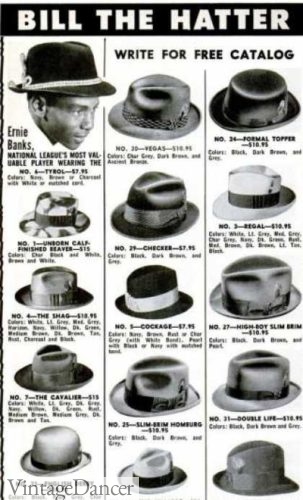
1950s Men’s Caps
The most casual of hats was the flat cap. Common at the turn of the century, it never went out of style but lost popularity in the last few decades. It was mostly worn by boys and working-class men.
In the ’50s the casual cap went mainstream again as sportswear for activities such as driving a car, playing golf, and hunting as well as general summer attire. The 8-panel cap was replaced by the English cap, oval cap and small cap. The overall shape was narrow but the patterns were large. Tartan plaid and big checks were favorites in summer. Nubby tweeds, corduroy and leather for the winter.

1955 men’s caps
- 1957 teen men’s coat and light cap
- 1959 mens coat and cap
Solid and smooth colors as well as textured tweeds, herringbone, and plaid were all options. The cap fit flat and moderately wide on the head, with the top stitched down to the brim at the center. They could be traditional 8 panels or a single round panel on top.
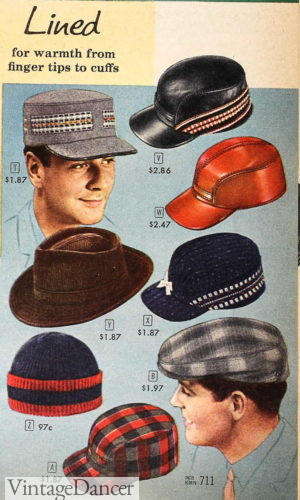
1959 winter sport caps hats
Buying 1950s Men’s Hats
There are far too many hat styles worn in the 1950s to capture the details of every one. Some, like the Homburg, remained in the same style as the 1940s. The Ivy cap remained popular since the 1930s without any significant change. And the Straw Boater remained a classic since the 1920s. They are timeless hats, making the men who wore them the only new thing about them.
Whenever possible, purchasing a vintage 1950s hat is the best choice. Hats of this decade in particular have become quite collectible in the last 15 years. Prices of a name brand hat in good condition can sometimes make them unaffordable to the average man. If this is the case for you, purchasing a new vintage style 1950s hat is a great option. Many new hats are similar if not replicas of original hats. Stetson hats are one brand still making high-quality hats today. Some newer brands like Sinatra Hats are reinventing vintage hats of the 1950s and adding just a touch of the modern to bring them back into fashion today.
1950s men’s hat shopping here
A handpicked selection of new, vintage style men’s 1950s hats.
Debbie Sessions has been teaching fashion history and helping people dress for vintage themed events since 2009. She has turned a hobby into VintageDancer.com with hundreds of well researched articles and hand picked links to vintage inspired clothing online. She aims to make dressing accurately (or not) an affordable option for all. Oh, and she dances too.
